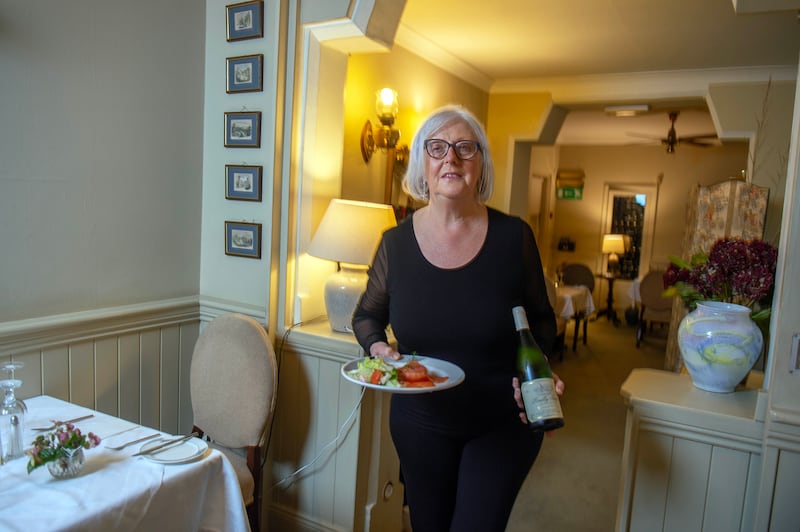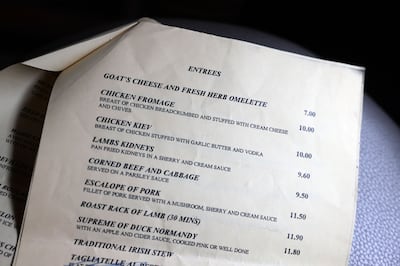Being a member of the service industry means different things in different countries. In Argentina and France, for instance, wait staff often have decades of experience behind them: it’s a career job. They intimately know their restaurants, their menus and their kitchens. The service they provide as a result can elevate the whole dining experience for a customer.
In many restaurants in Ireland, there is a much higher staff turnover. Frequently, whenever I’ve asked anything at all about menu items – provenance, how something is cooked, the meaning of a word I don’t recognise – the waiter has to vanish into the kitchen to ask the chef. In some places, the disconnect between the server and the food they are serving can be vast.
Earlier in the year, in Youghal, I was fascinated to hear my waitress tell a nearby diner she had been working in the same restaurant – Aherne’s – for more than 40 years. “Fresh off the boats this morning,” she said when I told her how phenomenally fresh and delicious my crab claws were.
Ann Cronin is her name, and she has been working in Aherne’s seafood restaurant for 43 years. “I went in one Wednesday, with no waitressing experience at all, and Betty and Gerry [Fitzgibbon, who developed the business after taking it over from Betty’s mother, Madge] interviewed me. I was asked to start that evening.”
When Cronin started in Aherne’s, there were paper mats on the table. “They had been specially designed. They said, ‘If you want chips, eat at the Wimpy down the street’. They were renowned for their seafood. It had started out with open crab sandwiches and soup and salmon sandwiches. Then they extended the business, and added 13 rooms, and the bar got much busier.”
[ Irish Times Food Month: more articlesOpens in new window ]
As she says now of how she learned on the job: “I just watched and I learned. I loved meeting people.” After some time, she went to work in the kitchen. Her specialities were brown bread, chicken liver pâté, and chocolate pudding, the last of which is still on the menu.
The most popular menu item over time? “Prawns in garlic. People came from all over the country for them. We get our prawns from Helvick in Ring.” They also serve Dover sole, oysters, turbot (her personal favourite) and other fresh shellfish and seafood.
How does she define good service? “You should acknowledge customers, seat them, give them a menu, give them bread, butter and water, and give a drink. People are quite happy to wait to order after you’ve done that.”

Over time, Cronin (72) went on to work for the Fitzgibbons’ sons, John and David. She says people eat earlier in the day now, post pandemic. They have a glass of wine, whereas before there would have been a bottle for the table. Their tips average at 10 per cent – “you take the good with the bad” – and are spread among everyone. They used to open seven days a week, but now close Mondays and Tuesdays. Cronin goes in at 5pm and the restaurant opens for 6pm. (Bar food is available from noon.)
Why has she stayed on so long? “I love the family I work for; they are like family to me, and they treat me like family. They trust you 100 per cent. I couldn’t change and work for someone else now.”
White linen on the tables long ago replaced the paper tablemats. The Wimpy down the street closed long ago. Chips still do not feature on the menu, but wedges do. One way or the other, the end of an era is approaching for Ann Cronin and Aherne’s: the entire premises is up for sale, at an asking price of €1.2 million.
The most popular menu item over the entire time Trocadero has been in operation is cannelloni. ‘That has been on the menu since the 1950s
Dubliners Jackie and Claire Gough are sisters. They live together, and they have also been working together for decades at Trocadero restaurant on St Andrew’s Street in Dublin. Trocadero, which has been in operation for more than 65 years, is now co-owned by Rhona Teehan and Robert Doggett. Its beautiful red velvet banquettes and atmospheric interior with scores of signed photographs of actors, and its endurance in a city where restaurants come and go has made it a cultural landmark.
“Trocadero is an ancient Greek word meaning ‘meeting place’,” says Jackie. (Trocadero is certainly a meeting place of old in Dublin, but when I look later I cannot find any kind of Greek word resembling “Trocadero”.)
Jackie started working in 1986 as a cleaner for three hours a day, and then came out on the floor. “The restaurant was half the size back then. It seated about 70. We have since extended and it seats 120.” Back then they were open seven nights a week, with last orders at half past midnight; they open six nights a week now, staying closed on Mondays. The most popular menu item over the entire time the restaurant has been in operation is cannelloni. “That has been on the menu since the 1950s.”

Claire was working in AA Insurance when her sister told her additional staff were needed at the bar. “I ended up giving up my secure, pensionable day job, and started here in 1999.” Claire is now a manager.
This was before the smoking ban. “I can still see piles of ashtrays on the bar,” she says. “We used to sell cigars, and we all had cigar cutters.” The nights were often long. “If a customer came in 12.30am, you’d be here till three or four in the morning, and you couldn’t go until your table was finished. Then it’d be: ‘Can we wait in here until the taxi comes?’ And they’d order another bottle of wine. It’d often be bright when we were leaving.”
Jackie says she knows what people are going to order before she reaches their table. “You just know what people will order by the look of them; do they want to sit and chat to you, or just order and you go. It’s one of the few restaurants where you can be hugged by customers when they are leaving.”
The cannelloni may still be the most popular item on the menu, but certain things have changed since the 1950s with table etiquette. These certain things drive Jackie mad.
“People who leave their phones on the tables, which means there is nowhere to put the food. People talking on their phones when you are tying to serve them. People who don’t say ‘please’ or ‘thank you’, when you take their orders or serve them.”
She said no. She said – I could hear her – ‘I thought we were just friends’
— Jackie Gough on overhearing an awkward private moment
The sisters recall some past regular customers. “There was a man who came at 5pm on a Thursday. He had Chicken Portuguese with a tomato sauce, a glass of orange juice with no ice, and a cup of tea. Every week, without fail. We didn’t actually have Chicken Portuguese on the menu any more, but we did it specially for him,” says Jackie.
Perhaps surprisingly, given the length of time some customers spend in the restaurant, there has been very little bad or messy behaviour. There is the odd sad story, though. “We’ve had dozens of proposals here,” says Claire. One evening there were a couple of regulars. The man had told the staff he was going to propose, and they hung about on the sidelines as usual, waiting to start the usual post-proposal fuss.
“She said no. She said – I could hear her – ‘I thought we were just friends’,” says Jackie.
“Could she not have waited until they got outside to tell him?” says Claire.
Despite what the beautiful, formal, scarlet-hued interior might suggest, Trocadero does not have a dress code. “One table would be glammed up to the nines, and the next one could be tourists in shorts,” says Jackie.
Why have they both stayed working so long at the Trocadero?
“We have great crack,” says Jackie.
“It’s like a family here. We have grown up together, we socialise together,” says Claire.



















